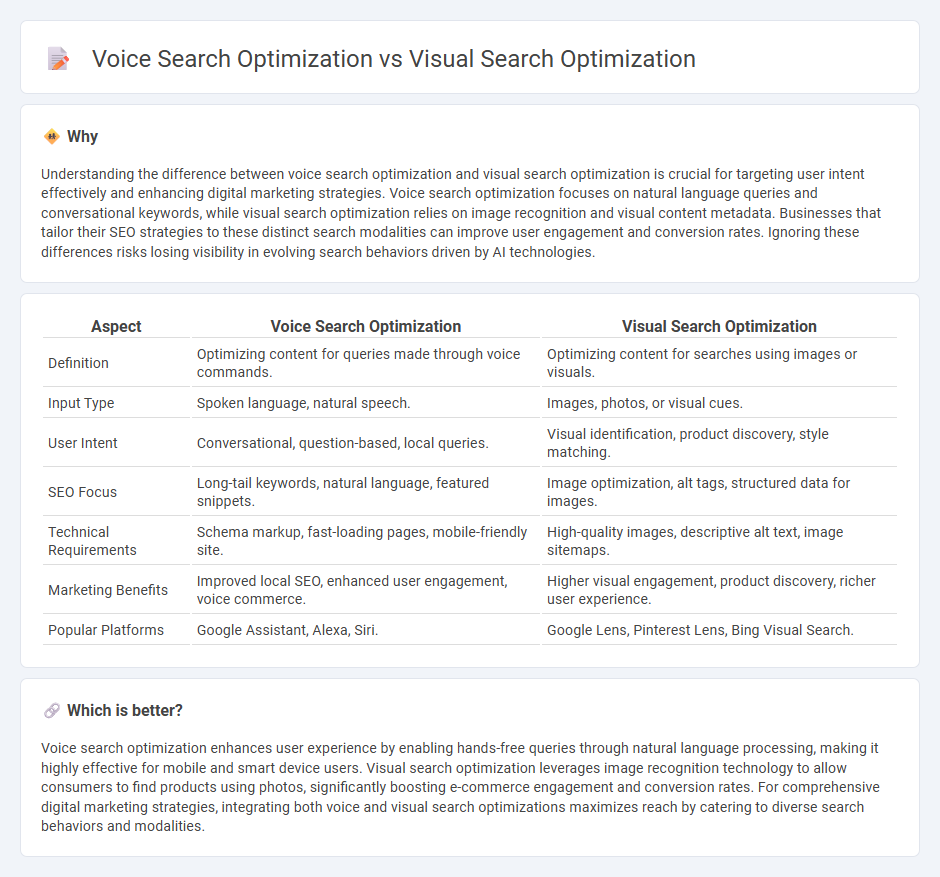
Voice search optimization leverages natural language processing to enhance user queries through spoken commands, focusing on conversational keywords and local search intent. Visual search optimization relies on image recognition technology, enabling users to find products and information using pictures instead of text, which requires detailed metadata and image tagging. Explore how these technologies can transform your marketing strategy for better customer engagement and conversion rates.
Why it is important
Understanding the difference between voice search optimization and visual search optimization is crucial for targeting user intent effectively and enhancing digital marketing strategies. Voice search optimization focuses on natural language queries and conversational keywords, while visual search optimization relies on image recognition and visual content metadata. Businesses that tailor their SEO strategies to these distinct search modalities can improve user engagement and conversion rates. Ignoring these differences risks losing visibility in evolving search behaviors driven by AI technologies.
Comparison Table
| Aspect | Voice Search Optimization | Visual Search Optimization |
|---|---|---|
| Definition | Optimizing content for queries made through voice commands. | Optimizing content for searches using images or visuals. |
| Input Type | Spoken language, natural speech. | Images, photos, or visual cues. |
| User Intent | Conversational, question-based, local queries. | Visual identification, product discovery, style matching. |
| SEO Focus | Long-tail keywords, natural language, featured snippets. | Image optimization, alt tags, structured data for images. |
| Technical Requirements | Schema markup, fast-loading pages, mobile-friendly site. | High-quality images, descriptive alt text, image sitemaps. |
| Marketing Benefits | Improved local SEO, enhanced user engagement, voice commerce. | Higher visual engagement, product discovery, richer user experience. |
| Popular Platforms | Google Assistant, Alexa, Siri. | Google Lens, Pinterest Lens, Bing Visual Search. |
Which is better?
Voice search optimization enhances user experience by enabling hands-free queries through natural language processing, making it highly effective for mobile and smart device users. Visual search optimization leverages image recognition technology to allow consumers to find products using photos, significantly boosting e-commerce engagement and conversion rates. For comprehensive digital marketing strategies, integrating both voice and visual search optimizations maximizes reach by catering to diverse search behaviors and modalities.
Connection
Voice search optimization and visual search optimization are interconnected through their reliance on artificial intelligence and machine learning to enhance user query interpretation. Both technologies improve search accuracy by analyzing natural language and image data, facilitating seamless interaction between spoken commands and visual inputs. Integrating voice and visual search strategies drives better user engagement and boosts conversion rates in marketing campaigns.
Key Terms
Visual Search Optimization:
Visual search optimization enhances user experience by enabling image recognition technologies to accurately identify and categorize visual content, boosting e-commerce product discovery and improving website traffic. Implementing structured data, high-quality images, and optimizing image alt texts contribute significantly to better indexing by search engines like Google Lens and Pinterest Lens. Explore advanced strategies and tools to elevate your visual search optimization effectiveness.
Image Alt Text
Image alt text plays a critical role in visual search optimization by providing descriptive, keyword-rich content that helps search engines understand the image context. For voice search optimization, alt text should be written in a natural, conversational tone to align with voice queries and improve accessibility. Explore how effective alt text strategies can enhance both visual and voice search performance for your website.
Schema Markup
Schema markup enhances visual search optimization by providing detailed image metadata that improves search engine comprehension of visual content and context. For voice search optimization, schema markup structures data to deliver concise, relevant answers aligned with natural language queries, boosting voice assistant accuracy. Explore in-depth strategies for leveraging schema markup to maximize both visual and voice search performance.
Source and External Links
How Voice and Visual Search are Transforming Marketing - To optimize for visual search, use high-resolution images with structured data markup to help search engines accurately connect images to queries, and leverage tools like Google Lens that integrate visual search technology and Google's knowledge graph for enhanced search relevance.
How to Optimize Images for Visual Search & AI Overviews - Key strategies include using high-quality, focused images, compressing files with next-gen formats (WebP, AVIF), and writing descriptive file names and alt text with relevant keywords to improve image discoverability in visual search results.
Guide to Visual Search: How To, Tools, Engines and Tips - Effective visual search optimization involves good image SEO (high-res images, descriptive filenames, relevant alt text), structured data markup (schema.org), and unique images to enhance search engine understanding and increase chances of rich snippet placement.
 dowidth.com
dowidth.com